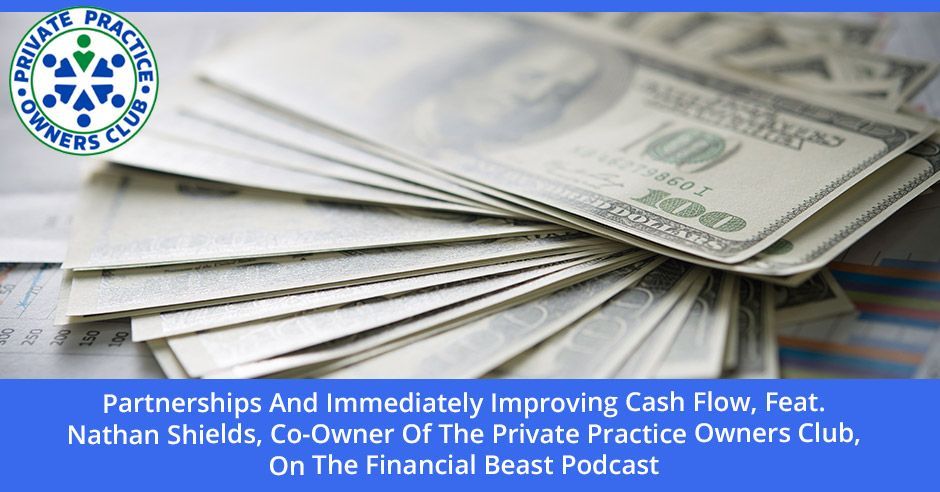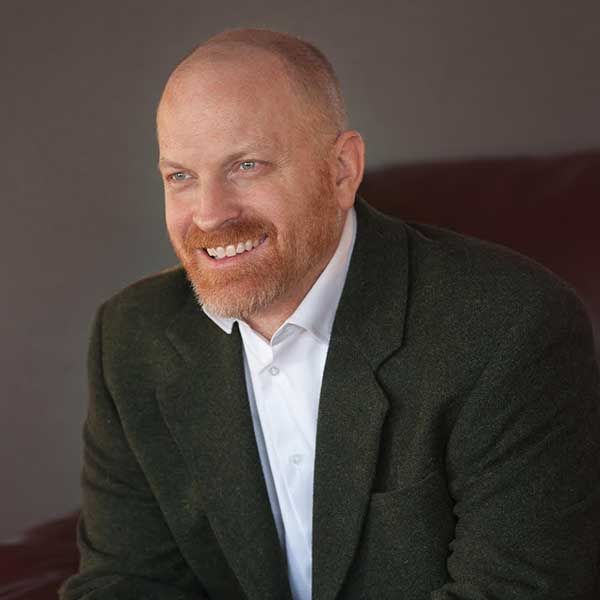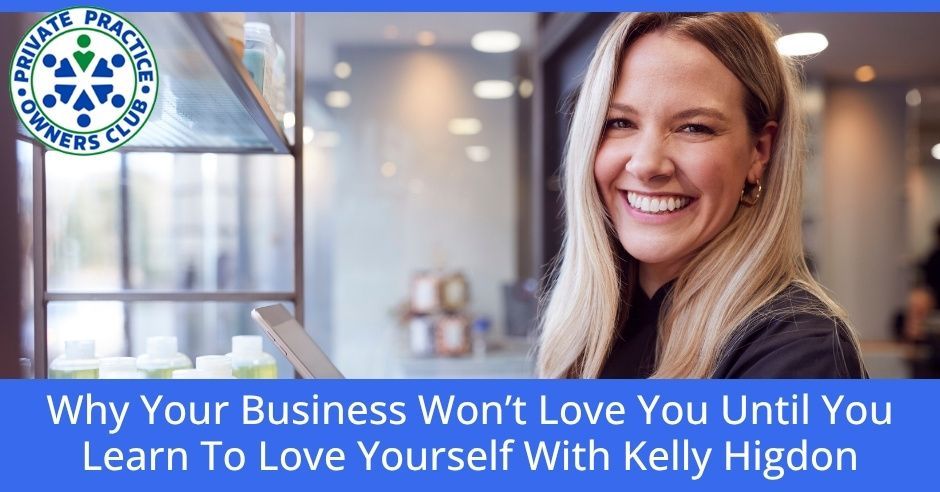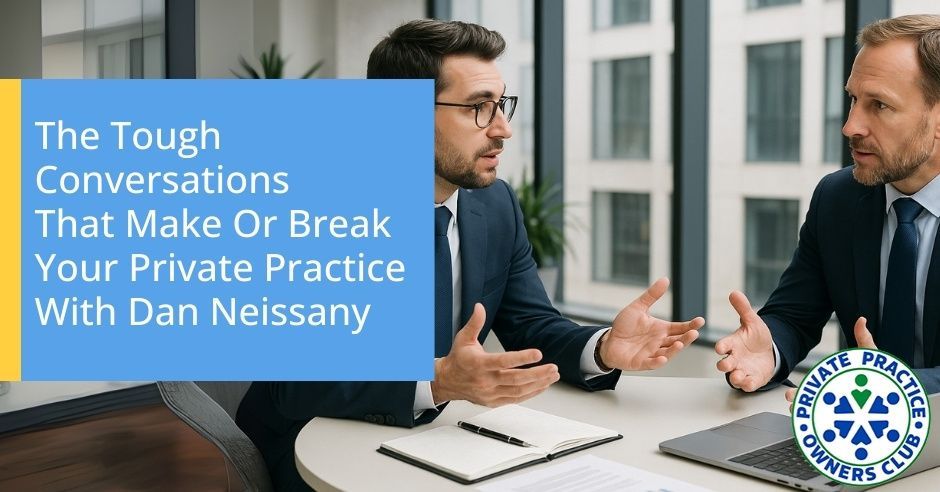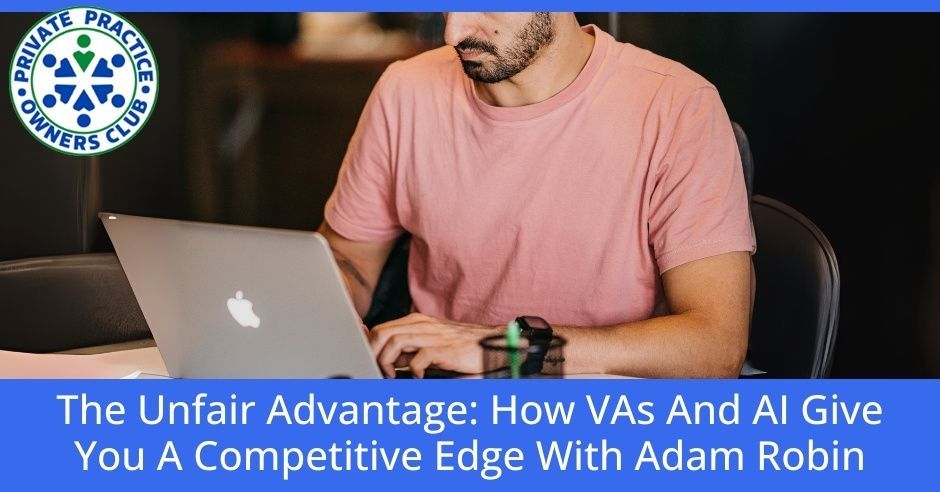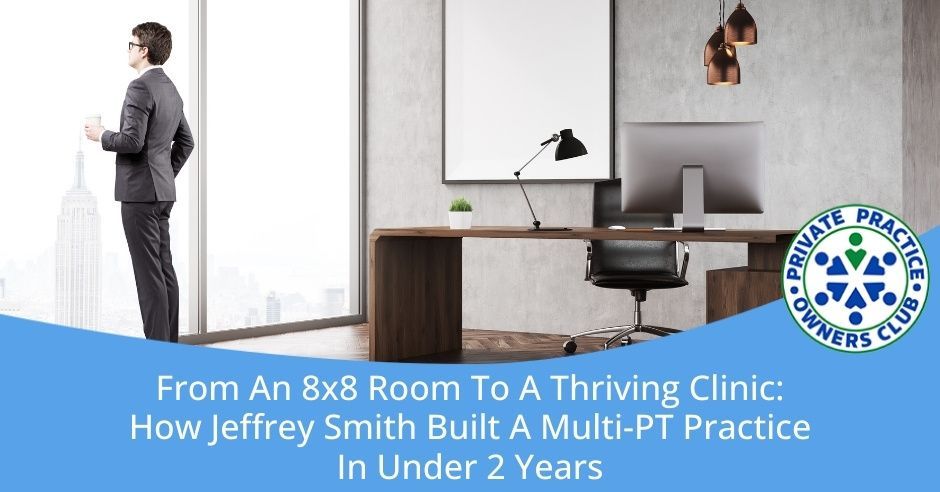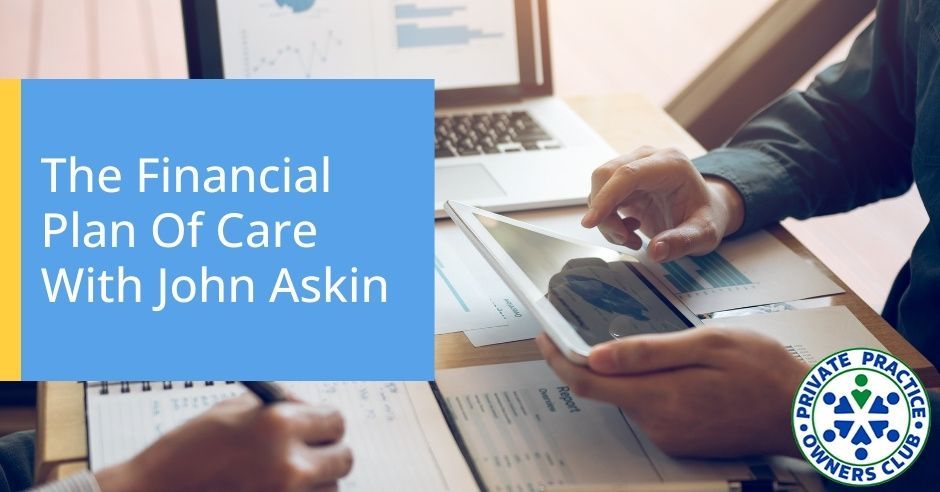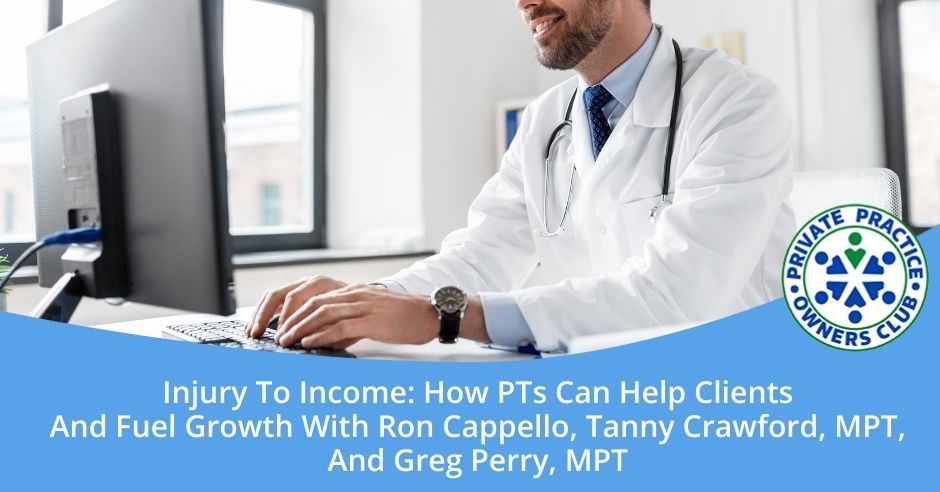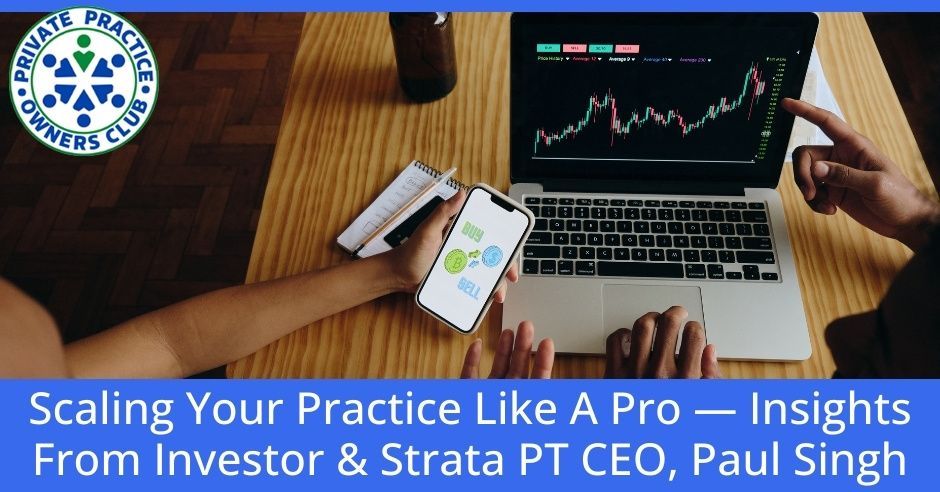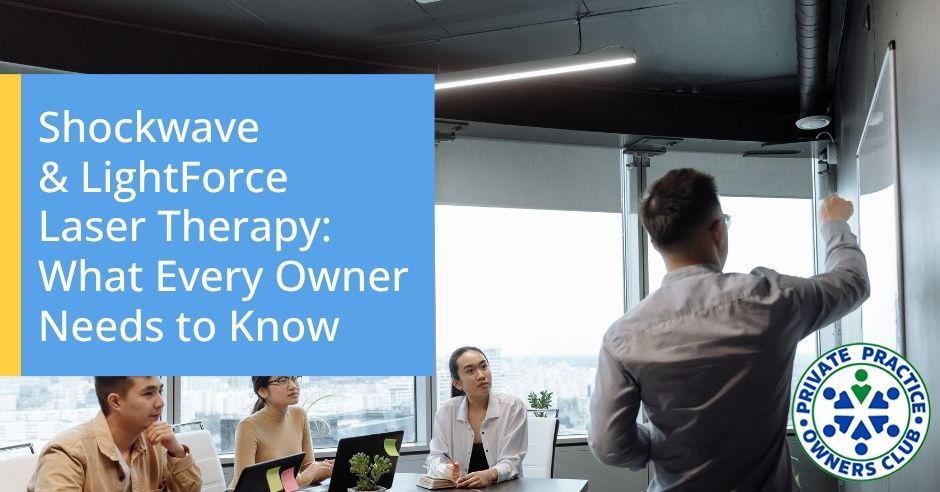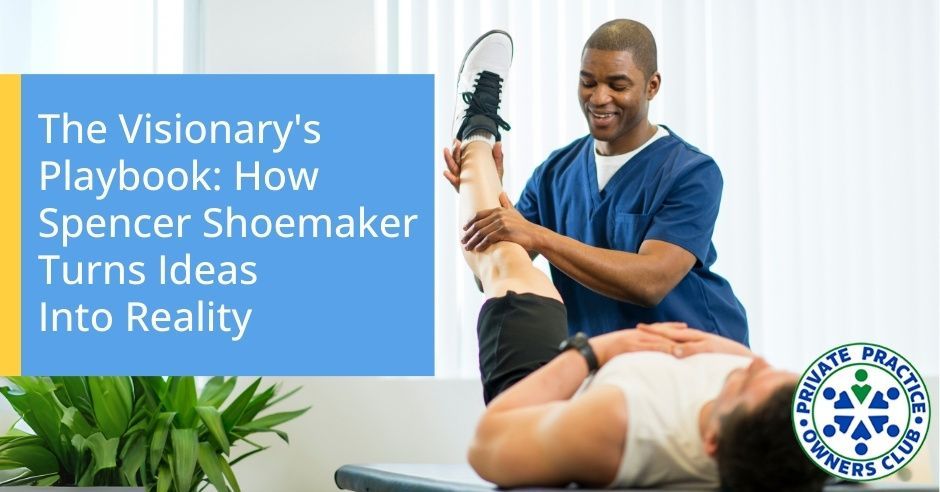Most private practice partnerships fail. But what if the right partner could double your growth and boost cash flow in weeks—not years?
In this episode of the Private Practice Owners Club podcast, Nathan Shields, co-owner of the Private Practice Owners Club and a seasoned entrepreneur, was invited by Eric Miller of Econologics Financial Advisors and host for The Financial Beast Podcast in a powerful discussion about – what makes a partnership not only functional—but wildly profitable.
Nathan shares the real-life strategies that helped him build trust-based partnerships, dodge common financial pitfalls, and scale a coaching business from scratch. But the episode doesn’t stop at theory—he also breaks down his 4-phase framework to instantly improve cash flow without seeing more patients.
If you're building a team, considering a partner, or just trying to finally pay yourself more, this episode is for you.
Episode Highlights
• 𝗪𝗵𝘆 𝗺𝗼𝘀𝘁 𝗽𝗮𝗿𝘁𝗻𝗲𝗿𝘀𝗵𝗶𝗽𝘀 𝗳𝗮𝗶𝗹 —and how Nathan built two thriving ones with zero drama.
• 𝗧𝗵𝗲 𝗼𝗻𝗲 𝗲𝘅𝗲𝗿𝗰𝗶𝘀𝗲 𝗡𝗮𝘁𝗵𝗮𝗻 𝗮𝗻𝗱 𝗵𝗶𝘀 𝗽𝗮𝗿𝘁𝗻𝗲𝗿𝘀 𝘂𝘀𝗲𝗱 𝘁𝗼 𝗮𝘃𝗼𝗶𝗱 miscommunication, resentment, and money fights.
• 𝗛𝗼𝘄 𝘁𝗼 𝘀𝘁𝗿𝘂𝗰𝘁𝘂𝗿𝗲 𝗽𝗮𝗿𝘁𝗻𝗲𝗿 𝗽𝗮𝘆 to prevent future headaches.
• 𝗧𝗵𝗲 𝟰 𝗽𝗵𝗮𝘀𝗲𝘀 𝗼𝗳 𝘆𝗼𝘂𝗿 𝗣𝗿𝗶𝘃𝗮𝘁𝗲 𝗣𝗿𝗮𝗰𝘁𝗶𝗰𝗲 you must clean up to unlock fast, sustainable cash flow.
• 𝗪𝗵𝘆 𝗸𝗻𝗼𝘄𝗶𝗻𝗴 𝘆𝗼𝘂𝗿 𝗯𝗿𝗲𝗮𝗸-𝗲𝘃𝗲𝗻 𝗽𝗼𝗶𝗻𝘁 𝗶𝘀𝗻’𝘁 𝗼𝗽𝘁𝗶𝗼𝗻𝗮𝗹 𝗮𝗻𝘆𝗺𝗼𝗿𝗲 —and how to track it without a CPA.
If you’ve ever wondered whether you’re under-earning, overworking, or just flying blind when it comes to your numbers—this episode is your wake-up call.
Learn how to align your vision, fix cash flow leaks, and build partnerships that fuel, not frustrate, your growth.
🎧 Tune in now and take notes—your practice and future depend on it.
👉 Visit our Linktree for Coaching Services, Free KPI Dashboard, Facebook Group, and Strategic Planning Services:https://go.ppoclub.com/linktree-podcasts
❤️ Love the show? Subscribe, rate, review, and share!https://ppoclub.com
---
Listen to the Podcast here
Partnerships And Immediately Improving Cash Flow, Feat. Nathan Shields, Co-Owner Of The Private Practice Owners Club, On The Financial Beast Podcast
This episode is from Eric Miller's show, which is the
Financial Beast. You can find his show out in the podcastosphere, whatever you call it, where I was a guest on his show. We had the opportunity to talk about a couple of things, partnerships, and how to increase cashflow immediately. I broke down the four phases that I discussed in my online course about how to improve cash flow and different aspects of your business without seeing any new patients.
You might want to check this out because we talked about two pretty significant things, and it takes a lot of time to break down, frankly. My experience with partnerships and how to create the most successful partnerships, and then after that, we lead into how to increase cashflow. I hope you enjoy it. Check out previous episodes that I've done with Eric Miller because he shares a ton of great insight on the show, but he also has this show, the Financial Beast, in which I was a guest. I'm happy to share it with you guys here. Let's check it out.
‐‐‐
Everybody, welcome back to the show. We are on a quest to help as many healthcare owners achieve financial stability by giving premier financial advice. Please check us out at
EconologicsFinancialAdvisors.com. If you're brand new to the channel, you know the drill. Like, share, and subscribe, so we can have awesome guests on, like we have now, Mr. Nathan Shields. Let's go. He is an owner and co-owner of multiple businesses, like the Private Practice Owners Club. You guys put together one of the larger physical therapy groups, I'd assume, in the industry.
We've got an awesome Facebook group that's got almost 1,500 members on there. We have our own coaching clients, and that's cool. I have been doing the show for six years, so there's a little bit of history and audience, for sure.
Building Powerful Partnerships: From Basics To Bedrock Values
You're in the game. You have a partner in the Private Practice Owners Club, Adam Robin. We were talking about partnerships, in general, because we've seen it be an issue. We're going to talk a little bit more about partnerships and how to improve your cashflow, but I do want to touch on partnerships. When they're good, they're good, and when they're bad, it's terrible. You've got two partners, right?
I've had two.
Serious business partners?
Yeah, not just people that share a financial interest in a common real estate project or something like that. These are legit. We're in the weeds together.
From what I can tell, it is a pretty successful partnership.
Listening to you, I count myself lucky. It sounds like 90% of the people that have partners that you're dealing with are having issues. I've never had issues before. I've found amazing people whom I can trust. We have open and honest conversations. We have pretty clear expectations. I can't complain. I don't get anxiety over getting on a call with them.
I look forward to talking to my partners. I'm sure plenty of people out there have a partner, and they're like, “I have to deal with this guy.” When you decided to go into business with these two, did you have a process, or was it like, “I like these guys. We're on the same purpose lines. I can get along with them pretty well,” and that was pretty much the extent of the decision at that point?
My process of partnering with Adam was completely different than my process of partnering with Will, which was several years ago. Years ago, I didn't know anything. We were like, “Do you want to partner? Let's do it.” That was it. The reason why I believe my partnership with Will worked so well was that we came from some very shared values. We met each other at church. You can't get more fundamental than that, right?
Shared values are fundamental to a strong partnership.
No. You had a basic bedrock of things you guys agreed upon, especially from a value system. That means a lot right there.
That told me a lot about him simply because we had the same experience through church and life experiences, because we shared the same religion. Initially, with Will, though, we worked together. He was a clinic director of mine in the clinic. I gave him a ton of autonomy to the point where I abdicated leadership because I didn't know what I was supposed to be doing as an owner overseeing a second location.
We still worked together. In spite of all my flaws, Will looked past them, thankfully. He was grateful for the opportunity to be a clinic director. We had some profit sharing. He loved it. Financially, it worked out for him. It worked out for me, too, to the point where he eventually bought that clinic from me, and then we went and opened a clinic together. Still, nothing was written in stone.
We had a lot of shared values and a lot of communication. It was like, “I'm having issues. What do you think?” or, “I'm having issues. What do you think?” We talk about it. It did get to the point, though, where we did merge all of the clinics that we had together. There were four clinics out there that were his, his, and ours. That's why we got a lawyer involved. They took us through, like, “These are the things that you need to consider. Let's figure out worst-case scenarios and how we're going to decide if there's an impasse between the two of you.”
You didn't do it right away, but you guys eventually did get all the agreements.
We had a very long honeymoon before we tied the knot. To compare and contrast, with my partnership with Adam, we worked together for about a year. That was my thinking the entire time, that we were eventually going to get to that lawyer situation. We talked about this initially. We did two things that were important. If I think of more, give me some leeway.
I don’t know if you know about Dan Sullivan's coaching program. He's a pretty popular coach out there. One of the forms that he uses for any project is called the one-page worksheet. It's for the ideal scene. You write down what your ideal scene is. I did that for the coaching business. I was like, “I am looking forward to working with Adam.
I had him do the same thing. What does he want out of the coaching business? What is his ideal scene working with me? In that, I got frank, I was like, “I do not want to do X, Y, and Z, and I expect X, Y, and Z.” He spelled out his expectations and ideal scene. We figured out we were both cool with each other's ideal scene. I remember the conversation. It's something I stole from someone else, frankly.
Most great ideas are stolen anyway, so what does that matter?
I said, “Let’s hit some singles.” What I mean by that is, “Let's try working together and see if some sparks start flying. If we're able to have some success together, if we work together, if we like talking to each other, meeting with each other, we share some similar ideas, and we're able to gain some traction with this thing, let's hit some singles, to use a baseball analogy, before we try to hit a home run. We frankly did that for about a year.
I will add one more thing there. I wanted to be very clear about what the payments were for work. I told him upfront, “There is no sweat equity in this. I don't want to have this conversation two years down the road and you say, “I did X, Y, and Z and I never got paid for it. I expect to get X, Y, and Z now.” It was upfront that I said, “I don't want to hear any of that.”
If you don't like that you are getting paid what you should get paid, then let's have a conversation about it and get what you think you should get paid if the company is making money. For technical work, there was a book that helped me with this. I can't remember what it was. It was something about sharing the pie. For technical work, it was like, “If you're going to coach, let's figure out now what your hourly rate for coaching is, and let's negotiate that. If it's cool with me and it's cool with you, then we'll put that kind of stuff in writing.
You're going to get paid this amount of money for coaching. You're going to get this amount of commission for a sale that you generate because you were going to be over sales. You're going to get paid this much per hour or whatever if you need to do some computer work. You're going to get paid every two weeks or every month.” There's not going to be this, we're going to put it together. If we did do that, then let's spell it out somehow. This is what we landed on. It could have been any other way. That book helped me figure that out.
To compare and contrast, I had years of a honeymoon period with Will before we got to the lawyer. I had a year of that situation with Adam with that initial conversation about how he was going to get paid and all that stuff, before we finally sat down with a lawyer, he had equity in the business, and all that kind of stuff. We still have and revisited the technical working rates and stuff like that. That's where we're at.
Adam doesn't share my faith system. He's not part of my church. I have to admit. He was my first coaching client a couple of years ago, so I also had a very good idea of who I was getting to business with based on what I saw in his work as a coaching client. That helped a ton. That helped with our relationship because we didn't jump into it quickly.
We've shared our ideal scenes and know what each other expects out of each other. We were very clear about those conversations regarding money because that seems to be one of the biggest hiccups. How are we going to spend money, and who's going to get paid for what? I try to knock those out of the way before we even agreed to work together.
Usually, it's what is the direction of the company, the money issue, and then the time and effort put in. Usually, it's frustration over one partner who's not putting in the time or effort, and another one's having to do all the work. It's the inequities of that.
I was very clear about that. Adam came to me and said, “I want to build something. I want to build a coaching business. I know you have a brand. I'd love to leverage your brand. Let's work together.” I said, “I don't want to do a lot with it. I don't want to coach.” I do coach here and there, but it's on my time and for the people that I want to coach. I don't want to be the guy who is doing the coaching for 10 people each, 20 calls a month, or whatever.
I was very clear about that. I wanted to be clear about it. I wanted to say, “There is going to be an inequity here. I'm not going to work as much as you, frankly, but I also want you to get paid for the work that you do. If you get paid your hourly rates and you'll get any distributions, I'll get paid hourly rates, which are nothing because I'm not doing anything, but I'm also going to get a distribution. You need to be cool with that.” Those were the conversations that we had initially. He was cool with that.
It worked because you guys expanded that thing. I remember you had 300 or 400 members. Now, you're up to 1,500 or something like that. It was crazy. It's growing all the time.
The same thing with our client load. I came in with 1 or 2 clients. They’re over 30 now. It has worked out well for us. He's putting a ton of work into it, but he's also getting paid very well. I don't get paid a lot unless we get a distribution. I purposely set that up to recognize the inequity in the work that we're doing. You're going to get compensated more for it, and that's fine with me.
That’s because you're not having to do most of the work at this point in time. Frankly, I'm taking on a little bit more as we're growing, but it’s in a situation where he's turned over his virtual assistant to me, who already knows how to do all this stuff. I have to oversee the virtual assistant, but it still doesn't take a lot of work.
The Cash Flow Conundrum: Understanding Your Business Finances Deep Dive
Let's turn to cashflow because that's another one that we always like to talk about here. A lot of people don't. I don't know why.
They don't want to talk about cashflow?
No. They hate it. It is interesting to get the viewpoints when it comes to money, finances, and talking about all that.
That's where the dreams are.
You have to know it. How can you manage something where the money coming into the organization, if you don't know how to manage it, could either cause the expansion or cause the destruction? You have to know how that works and how the inner pipes work. Money is an interesting thing. I know part of what you wanted to talk about was the four methods. Was it the four methods to improve cash flow?
The four phases of your business that you need to address in order to maximize cashflow. A few years ago, I was working with a client. As we're getting off the call, he's like, “Nathan, I need to know how to increase my average reimbursement per visit.” I'm like, “We're at the end of the call. We could spend another two hours talking about this.”
I put things down on paper, and it came to mind pretty easily how this needs to come together. I thought, “I need to get this out more.” I made an online course,
PTCourses.com, I think. I don’t know. I forgot. I need to do better at promoting and marketing. I also presented it at our conference in September 2024. We had our first annual Private Practice Owners Club Conference in September 2024 in Clearwater, which you attended.
I am looking forward to the next one, which is?
October 2nd through 4th, 2025, in Destin, Florida.
If you are a physical therapist, make sure you are there.
If you're any type of private practice owner. It doesn't have to just be a physical therapist. We're coaching speech therapists and pediatricians. We got OTs on board. We don't have a landing page yet. I would say this. Make sure you join the Facebook group,
Private Practice Owners Club. Look for that on Facebook. You'll see all the notifications that we post on there. We'll probably be putting out a landing page in another month or so, depending on when this release is. That should be the first part of May 2025.
You can also find us on LinkedIn. If you go to the show, we're going to have ads in there as well. It's the Private Practice Owners Club show. There are over 300 episodes. Yours truly hosts it, my BFF here. Is BFFF? That would've been on a lot of them. He has given a ton of them. You'll see a lot of good content there if you're a practice owner. We'll post it there.
I did the course and presented this at the conference, and then we did a workshop in New York City and presented the same material because it's super valuable. I would assume that most owners would want to increase their revenues 10% without doing much more and without having to see more patients, frankly. You can do that if you clean up your systems a little bit. I’m serious. It's not a lot of work. Hopefully, that translates or comes across during the course of this conversation.
There are four phases to consider. By cleaning up these four phases, I can promise you, you're going to increase your revenue and thus should increase your profit because expenses stay the same. You increase your profit by even more, this is take-home cash in your pocket, by addressing these internal systems and cleaning them up.
Phase 1: Knowing Your Financial Numbers
They're not that difficult. I put them in sequence from easiest to implement to hardest to implement, and quickest return on cashflow to longest return on cashflow. There are four phases. Those four phases are knowing your financials and getting that dialed in, being good at over-the-counter collections, which I’ll explain what good means, and properly holding your billing collections team accountable, which is a super weak spot for a lot. They don’t know how.
Phase 4: Maximizing Billing & Coding Procedures
The fourth part is maximizing your billing and coding, like getting you or your providers to maximally bill for all the services you provide at every visit. Starting with the first one, knowing your financial numbers, I'm sure you've brought it up many times with Eric on the show. Maybe you discussed it a little bit, but would you say that most private practice owners that you come across aren't very knowledgeable regarding their financial metrics?
They all usually have the wrong number when it comes to what they think they need to bring in. When you say know your numbers, make sure that they're correct. I’m assuming you're talking about, “I know what needs to come into the organization for me to be able to operate, expand, and solve it.”
There are a lot of KPIs. There are a lot of stats that you could be aware of, but what you're talking about is what's commonly known as the breakeven number. What's your breakeven? That is covering all your expenses plus 10% profit. What is that number, either in terms of cashflow or visits per week? You probably need to know both numbers, frankly. What's your baseline?
Everyone's going to guess their average reimbursement per visit, which is a key KPI. Yet, they're probably not tracking it month to month. They're probably guessing, not knowing the specifics. More importantly, they don't know what their cost per visit is. If they don't know their cost per visit, they don't have a good idea whether or not that low-paying insurance contract is making them money or not. When you're also talking about financial metrics, you're talking about what your profit margin is. Is it in the single digits? If it is, then what could you be doing better? Owning a company and getting single-digit profit returns isn't worth your while, wouldn't you say?
Owning your company and getting single digit profit returns isn't worth your while.
It sucks. That's not why you got the business.
These are some of the basic KPIs and financial statistics you need to know. I recommend that you talk to your CPA, bookkeeper, or whoever's reconciling your accounts every month. If there's one thing that they didn't teach us in physical therapy, occupational therapy, or speech therapy schools, it is how to run your business and know your financial metrics.
For me, I had to tell my CPA at one point, “You and I are going to sit down once a month. You're going to talk to me for an hour and explain to me what a profit and loss statement and a balance sheet are, and how to read my financials. He's like, “Cool.” You pay the tuition and meet with those people so they can show you exactly what's going on.
You look at the monthly financials and do the month-over-month comparisons or the year versus previous year comparisons. You look at your balance sheet and outstanding expenses that are $2,000 more this month than they were last month. Was it an itemization problem? Was it someone going crazy with your credit card?
You look at that stuff, and the underlying principle is that which gets measured improves. If you are looking over your financials purposefully and intentionally to improve the financial health of your company, then your financial health will improve. Knowing the data forces your hand. You can still be lazy about it. It does tell you what to do. It's a great starting point. You have to have the awareness of that. Be aware.
You have to have credit cards on file for every patient, no matter what excuse.
Phase 2: Over-The-Counter Collections
To go further on that guiding principle, which is that which gets measured improves, that which gets measured and reported improves exponentially, which leads me into the second phase. That is over-the-counter collections. If you want to improve your collections, then implement a system of daily accountability for overcount collections. When we're talking over-the-counter collections, that's every copay that's straightforward. It's usually determined by the insurance company. They tell you, “Collect $20 or $30 a visit,” or whatever.
Co-insurances are a little bit more nebulous than deductibles. If it's early in the year, your front desk person might not be too sure what to collect. At that point, the people who are doing well with over-the-counter collections and don't have a lot of outstanding patient balances later on are the people who are saying, “We're going to take a good guess as to how much you need to pay for this visit.” We're not going to leave it for the insurance to figure out and come after you later. We're going to collect it.
If we have to cut you a check, we'll do that, but I would much rather cut a check than chase you down for $50. That takes more energy from my team. I’m like, “Let's get the $150 over the course of these next 2 visits and save the time and energy. Right? Getting that money now is significantly better than trying to get it later.
It was a McKinsey study. I have a hard time finding it, but I know it's out there. It said that anything that's not collected at the time of service, you're losing 50% to 60% of that dollar if it's not paid at that time. If your outstanding patient balance is $20,000 on your aging AR, you can maybe collect 10,000 of that. You could have collected $20,000 if you had collected at the time of service.
For those people who are saying, “People aren't going to pay at the time of service,” then maybe you could be collecting $15,000 at the time of service. It works out in your favor. Don't be the bank. You're not a bank. You're providing a service. We should expect to get paid. The question sometimes becomes, “How much do I expect them to pay if they haven't met their deductible or co-insurance?”I say, “It’s easy. If you don't want to go through the process of figuring out which insurance is going to pay, and how much, it's going to be different for every payer and every patient.
If you are average reimbursement rate, you can expect it to be $100 a visit. If they haven't met the deductible, collect $100 a visit. If you overshot it, send them a check. It's a lot easier to handle. If their co-insurance is 40% and you get a $100 visit, then you're collecting 40% every visit, no matter what. That right there would make a drastic difference, but it still doesn't come back to the guiding principle, which is that what gets measured and reported improves exponentially. The one expectation is that we're going to collect everything at the time of service. I broke that down as one.
That which gets measured improves; that which gets measured and reported improves exponentially.
The next step, though, is to get your front desk person who's collecting these to report those collections every day at the end of every day. This was our process. If today is a Monday, tonight, they would fill out a sheet. Some EMRs can do this, and some of them can't. Back in the day, we had to do it manually. We had this Excel spreadsheet. If you want a sample of that, email me at
Nathan@PPOClub.com. I'll give you a sample spreadsheet for your front desk to write out.
On that spreadsheet, on the very left-hand side, they're going to list all the patients that are coming tomorrow, on Tuesday. In the next column, it's going to say, “How much are you expected to collect on their copay tomorrow?” It goes down exactly how we talked about, whether it's copay, coinsurance, or deductible, you write down each one.
That's the sheet. They prepare that tonight, and then tomorrow, whoever's running the front desk, follows that sheet. It’s like, “John Smith, you got a $20 copay. How are you going to pay that?” You go through the day like that. In Arizona, you can do four activities. It's usually no problem. You need to learn the system and start to start navigating.
Some insurances don't like it, but some insurances don't care. You need to know as the owner and train your team on XYZ insurance. We're going to build this code all the time because it maximizes care. We're going to justify it accordingly with our documentation that we can ethically bill for it and show our reasoning behind it. This XYZ insurance isn't going to let us do that. We know we have to bill the therexes and the manuals. Maybe that one allows you to do a reevaluation code that you could do with the other one, and that's how you maximize prep.
You have to know these things. It's work that you do with your billing team. When they get a denial then they tell you, “This code isn't working in combination with that code,” or, “We do better,” if you bill these codes together instead of those codes, that's where you start manipulating the system, frankly because that's what the insurance companies are doing to you. If you want to get paid the most for your services, you have to know how to navigate some of these differences between insurances and between codes.
It's a giant quagmire, but you have to try to understand the quagmire as best as you can.
There are some billing companies that are doing better, or maybe even some AI services. Athelas was a sponsor at the conference. They have an AI billing program that, frankly, can handle some of that stuff. When a denial comes in, they don't have to wait for someone to handle it manually. The AI program already knows what to do with that denial and kicks it back out in real-time with the changes that need to be made. Some of that stuff is coming down the pipe or is here. Athelas has that. There will be more. The AI component's going to be helpful because insurance companies are using AI already.
To deny you, so you're going to need to fight fire with fire.
We're behind the eight ball because they're already doing it. We need to do the same. There's knowing the billing collections game. Not only managing them, but also how to maximize your reimbursement rates visit to visit is huge. I can't state enough. Those owners then have to train their providers. Coming out of physical therapy school, in our case, they're going to teach you Medicare billing guidelines.
If you use Medicare billing guidelines across all the commercial payers, you are losing money. In AMA billing guidelines, which are a lot by the commercial payers, you can see a patient for less amount of time and bill the same amount of units. That's the game as well. You have to train that out of your providers because they're coming out of school like that.
In doing that, and you understand this concept pretty well, the owner can't be doing that training because they're thinking, “You're telling us how to manipulate the system so you can make more money.” That might be a default thought process. Not only that, but your team members tend to accept the training from people who are more of their peers or whom they see as experts and not the owner.
If you use a Gawenda, if you do some trainings through Medbridge billing, coding, and stuff like that, or who else is out there that does it? I'm not sure. Those are the two that come to mind, Gawenda and Medbridge. Let them do the training. That way, it's a third party. If there's any kickback, then you can go back to the third party and say, “What does it say we can do? Let's use that. Can we agree that he's the expert and we'll do what they say?” Instead of fighting with you as the owner. The owner has to have the knowledge first, and then they can implement those changes.
Phase 3: Managing Your Billing Collections Team
Back to what I was talking about, I laid those four situations out from easiest to hardest because it should be easy to get your numbers. It is pretty easy to make some over-the-counter collections changes if you want to. Managing the billing collections team and then getting their provider team to change their billing and coding practices can take a little bit more work. If you spend the next 3 to 4 months on this, we're talking an increase in revenue, like 15% to 20%.
It is enormous.
It's huge. It doesn't sound like a lot. You change your average reimbursement rate by $5 a visit, which is closer to a 5% or 6% change. If you get your average reimbursement rate up to $5 or $6 a visit, translate that over 10,000 visits. It’s all cash and money. It's all profit. You're not increasing your expenses. You're improving your internal systems.
Good stuff. That was granular. You went deep.
I hope I didn't go too long on it. This is me. The reason why I got deep into it is, if I were listening, how do I do that? I need to know the granular because that's where I get hung up. If someone doesn't tell me how to do it, then I'm stuck, like, “I don’t know where to go next.” Hopefully, I didn't take up too much time.
That was good. Thank you.
I know I was going off.
Implementing And Maintaining Systems: Long-Term Financial Success
It was needed to help me in the industry because there are parts of it that I wouldn't have even thought about. You went from the easiest, gradient down to the most difficult. All those things combined together, is it worth all the time and effort to increase your revenues by 10% to 15%? Yes. Imagine how different your life is going to be if you increase that amount.
I've taken people through my course. They probably spend 4 hours on average and 3 to 5 hours a week on this stuff. Upon doing that, do that for about 3 to 4 months, and it makes a significant change. This isn't a 40-hour per week effort. This is to improve your systems with a little bit of effort every week. Maintaining them afterwards is significantly less. It's an hour a week, maybe.
That will 100% improve your bottom line and make life a lot easier because of that.
We need to. We're getting thin margins already. The next conversation or the next course, frankly, is how to negotiate insurance contracts or drop them altogether. I would tell people, even if I had that course, when I built it out, “I don't want to take you through that negotiating and dropping insurance contracts course until you have your internal systems.”
All your rudiments are in first before you can do that.
If your reimbursement's better and you're still stuck on the other things, it's not going to prove that much.
You're still going to lose money.
You need to have a handle on your financials. You need to be on top of your cashflow. I'm talking from experience. I didn't start doing this stuff until ten years into ownership. I can't imagine how many tens of thousands, if not hundreds of thousands of dollars, I lost by not having systems like this. Learn from the village idiot. Let me teach you how to make more money.
That's good. You gave your email out. How do you want people to reach you, and the easiest way to do it?
It is
Nathan@PPOClub.com. If you have questions, especially about some of these financial things, I'd love to talk to you. There is no obligation. I am happy to talk to you. On the group side, if you want to be part of a bigger group that is having these conversations, and you want to know about what we're doing in the future. That's the Private Practice Owners Club in the Facebook group.
We have a website,
PPOClub.com, where you can learn a little bit more about us and schedule an appointment. You can also reach out to me directly. We have the Private Practice Owners Club show. If you are a consumer, I'd like to say, I don't promote myself a lot. “I think we've got one of the better, if not the best, private practice shows focused on business that's out there. There's a ton of valuable content on there. Financials is a small part of it. We're talking about everything from recruiting to mindset to time management, a lot of small business stuff in general. It's great. You got to check out the show. I highly recommend that.
I appreciate it. Thanks so much.
No problem. This was great.
Important Links



